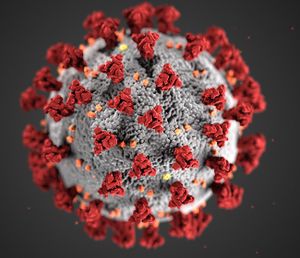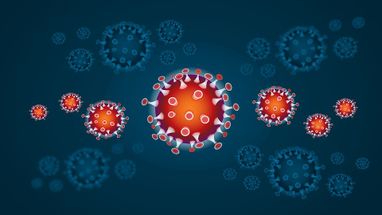Coronavirus Disease (COVID-19): Difference between revisions
Candace Goh (talk | contribs) No edit summary |
Rachael Lowe (talk | contribs) mNo edit summary |
||
| Line 7: | Line 7: | ||
== Introduction to COVID-19 == | == Introduction to COVID-19 == | ||
The World Health Organisation (WHO) has declared the coronavirus disease 2019 (COVID - 19) a pandemic<ref>World Health Organization. WHO Director-General's opening remarks at the media briefing on COVID-19 - 11 March 2020. Available from: https://www.who.int/dg/speeches/detail/who-director-general-s-opening-remarks-at-the-media-briefing-on-covid-19---11-march-2020 (Accessed 14 March 2020)</ref>. A global coordinated effort is needed to stop the further spread of the virus. A pandemic is defined as a “occurring over a wide geographic area and affecting an exceptionally high proportion of the population”<ref>Marriam Webster Dictionary. Pandemic. Available from:https://www.merriam-webster.com/dictionary/pandemic (Accessed 14 March 2020)</ref> The last pandemic reported in the world was the H1N1 flu pandemic in 2009. | The World Health Organisation (WHO) has declared the coronavirus disease 2019 (COVID-19) a pandemic<ref>World Health Organization. WHO Director-General's opening remarks at the media briefing on COVID-19 - 11 March 2020. Available from: https://www.who.int/dg/speeches/detail/who-director-general-s-opening-remarks-at-the-media-briefing-on-covid-19---11-march-2020 (Accessed 14 March 2020)</ref>. A global coordinated effort is needed to stop the further spread of the virus. A pandemic is defined as a “occurring over a wide geographic area and affecting an exceptionally high proportion of the population”<ref>Marriam Webster Dictionary. Pandemic. Available from:https://www.merriam-webster.com/dictionary/pandemic (Accessed 14 March 2020)</ref> The last pandemic reported in the world was the H1N1 flu pandemic in 2009. | ||
On 31 December 2019, a cluster of cases of pneumonia of unknown cause, in the city of Wuhan, Hubei province in China, was reported to the World Health Organisation. In January 2020, a novel coronavirus was identified and samples obtained from cases and analysis of the virus’ genetics indicated that this was the cause of the outbreak. The virus is referred to as SARS-CoV-2 and the associated disease is COVID-19<ref>Public Health England. COVID-19: epidemiology, virology and clinical features. Available from:https://www.gov.uk/government/publications/wuhan-novel-coronavirus-background-information/wuhan-novel-coronavirus-epidemiology-virology-and-clinical-features (Accessed 14 March 2020)</ref> | On 31 December 2019, a cluster of cases of pneumonia of unknown cause, in the city of Wuhan, Hubei province in China, was reported to the World Health Organisation. In January 2020, a novel coronavirus was identified and samples obtained from cases and analysis of the virus’ genetics indicated that this was the cause of the outbreak. The virus is referred to as SARS-CoV-2 and the associated disease is COVID-19<ref>Public Health England. COVID-19: epidemiology, virology and clinical features. Available from:https://www.gov.uk/government/publications/wuhan-novel-coronavirus-background-information/wuhan-novel-coronavirus-epidemiology-virology-and-clinical-features (Accessed 14 March 2020)</ref> | ||
| Line 18: | Line 18: | ||
WHO: Coronavirus - Questions and Answers by World Health Organisation published on 16 January 2020 | WHO: Coronavirus - Questions and Answers by World Health Organisation published on 16 January 2020 | ||
{{#ev:youtube|OZcRD9fV7jo}} | {{#ev:youtube|OZcRD9fV7jo}} | ||
This novel coronavirus was named Coronavirus Disease | This novel coronavirus was named Coronavirus Disease 2019 ( COVID-19) by WHO in Febuary, 2020.<ref>World Health Organization. [https://www.who.int/dg/speeches/detail/who-director-general-s-remarks-at-the-media-briefing-on-2019-ncov-on-11-february-2020 Director-General's remarks at the media briefing on 2019-nCoV on 11 February 2020]. 2020/2/18)[2020-02-21]. <nowiki>https://www</nowiki>. who. int/dg/speeches/detail/who-directorgeneral-s-remarks-at-the-media-briefing-on-2019-ncov-on-11-february-2020. 2020.</ref> This viral diseases, corona viruses, are [[Zoonotic Diseases|zoonotic]]<ref>Chan JF, Lau SK, To KK, Cheng VC, Woo PC, Yuen KY. [https://scholar.google.com/scholar_url?url=https://cmr.asm.org/content/28/2/465.short&hl=en&sa=T&oi=gsb&ct=res&cd=0&d=18418614767959378872&ei=jGJsXoeOF4qXmAHK-JDgDQ&scisig=AAGBfm2ifjtuJuk1qQbAFy39C6RZOroQfA Middle East respiratory syndrome coronavirus: another zoonotic betacoronavirus causing SARS-like disease.] Clinical microbiology reviews. 2015 Apr 1;28(2):465-522.</ref> and COVID-19 is not only a contagious [[Respiratory System|respiratory]] diseases and it can also cause epidemics<ref>Levine, D., Spratt, H., Hanks, J., & Woods, C., 2020. ''Novel Coronavirus: [http://www.apta.org/Blogs/PTTransforms/2020/3/10/CoronaBestPractices/ A Wake-Up Call For Best Practices In Preventing Pathogen Transmission.]''[online] Available at: <<nowiki>https://www.apta.org/Blogs/PTTransforms/2020/3/10/CoronaBestPractices/</nowiki>> [Accessed 14 March 2020].</ref>. Like the Severe Acute Respiratory Syndrome (SARS) virus that first appeared in China, COVID-19 was also first identified in Wuhan, China, in December 2019. Given the fact that this condition can currently be described as a pandemic condition, there is no definitive cure for this disease. Nevertheless, the prevention mechanism by activating the infection control mechanism is necessary to minimise the spread of the disease. [[Oxygen Therapy|Oxygen therapy]] and other symptomatic treatment of a person with COVID-19 are also standard means of care. | ||
== What is Coronavirus? == | == What is Coronavirus? == | ||
| Line 32: | Line 32: | ||
Coronaviruses are [[Zoonotic Diseases|zoonotic]]. This means that the viruses are transmitted between animals and humans. It has been determined that MERS-CoV was transmitted from dromedary camels to humans and SARS-CoV from civet cats to humans<ref name=":0" />. The source of the SARS-CoV-2 (COVID-19) is yet to be determined, but investigations are ongoing to identify the zoonotic source to the outbreak<ref>Public Health England. COVID-19: epidemiology, virology and clinical features. Available from:https://www.gov.uk/government/publications/wuhan-novel-coronavirus-background-information/wuhan-novel-coronavirus-epidemiology-virology-and-clinical-features. (Accessed 14 March 2020)</ref>. | Coronaviruses are [[Zoonotic Diseases|zoonotic]]. This means that the viruses are transmitted between animals and humans. It has been determined that MERS-CoV was transmitted from dromedary camels to humans and SARS-CoV from civet cats to humans<ref name=":0" />. The source of the SARS-CoV-2 (COVID-19) is yet to be determined, but investigations are ongoing to identify the zoonotic source to the outbreak<ref>Public Health England. COVID-19: epidemiology, virology and clinical features. Available from:https://www.gov.uk/government/publications/wuhan-novel-coronavirus-background-information/wuhan-novel-coronavirus-epidemiology-virology-and-clinical-features. (Accessed 14 March 2020)</ref>. | ||
== Clinical Presentation == | |||
Among those who will become infected, some will show no symptoms. Those who do develop symptoms may have a mild to moderate, but self limiting disease with symptoms similar to the seasonal flu [REF]. Symptoms may include: | |||
* Respiratory symptoms | |||
* Fever | |||
* Cough | |||
* Shortness of breath | |||
* Breathing difficulties | |||
* Fatigue | |||
* Sore throat | |||
* Pneumonia in more severe cases | |||
A minority group of people will present with more severe symptoms and will need to be hospitalised, most often with pneumonia, and in some instances the illness can be so severe that it can lead to death [REF]. Emergency warning signs where immediate medical attention should be sought [REF] include: | |||
* Difficulty breathing or shortness of breath | |||
* Persistent pain or pressure in the chest | |||
* New confusion or inability to arouse | |||
* Bluish lips or face | |||
== High risk population == | |||
== High risk population | |||
== Diagnostic Procedures == | == Diagnostic Procedures == | ||
Revision as of 11:27, 15 March 2020
Original Editor - Tolulope Adeniji.
Top Contributors - Rachael Lowe, Wanda van Niekerk, Kim Jackson, Admin, Lucinda hampton, Nikhil Benhur Abburi, Candace Goh, Tolulope Adeniji, Vidya Acharya, Jess Bell, Tarina van der Stockt, Anas Mohamed, Nicole Hills, Marleen Moll, Tony Lowe, Richard Benes, Leana Louw, Oyemi Sillo, Natalie Patterson, Olajumoke Ogunleye and Simisola Ajeyalemi
Introduction to COVID-19[edit | edit source]
The World Health Organisation (WHO) has declared the coronavirus disease 2019 (COVID-19) a pandemic[1]. A global coordinated effort is needed to stop the further spread of the virus. A pandemic is defined as a “occurring over a wide geographic area and affecting an exceptionally high proportion of the population”[2] The last pandemic reported in the world was the H1N1 flu pandemic in 2009.
On 31 December 2019, a cluster of cases of pneumonia of unknown cause, in the city of Wuhan, Hubei province in China, was reported to the World Health Organisation. In January 2020, a novel coronavirus was identified and samples obtained from cases and analysis of the virus’ genetics indicated that this was the cause of the outbreak. The virus is referred to as SARS-CoV-2 and the associated disease is COVID-19[3]
As of 15 March 2020, over 156,000 cases have been identified globally in 123 countries with a total of over 5,000 fatalities. Live data can be accessed here.
Novel Coronavirus (2019-nCoV) by World Health Organisation, published on 31 January 2020:
WHO: Coronavirus - Questions and Answers by World Health Organisation published on 16 January 2020
This novel coronavirus was named Coronavirus Disease 2019 ( COVID-19) by WHO in Febuary, 2020.[4] This viral diseases, corona viruses, are zoonotic[5] and COVID-19 is not only a contagious respiratory diseases and it can also cause epidemics[6]. Like the Severe Acute Respiratory Syndrome (SARS) virus that first appeared in China, COVID-19 was also first identified in Wuhan, China, in December 2019. Given the fact that this condition can currently be described as a pandemic condition, there is no definitive cure for this disease. Nevertheless, the prevention mechanism by activating the infection control mechanism is necessary to minimise the spread of the disease. Oxygen therapy and other symptomatic treatment of a person with COVID-19 are also standard means of care.
[edit | edit source]
Coronaviruses are a family of viruses that cause illness such as respiratory diseases or gastro-intestinal diseases. Respiratory diseases can range from the common cold to more severe diseases, such as Middle East Respiratory Syndrome (MERS-CoV) and Severe Acute Respiratory Syndrome (SARS-CoV)[7] A novel coronavirus (nCoV) is a new strain that has not been identified in humans previously. Once scientists determine exactly what coronavirus it is, they give it a name (as in the case of COVID-19, the virus causing it is SARS-CoV-2).
Coronaviruses got their name from the way that they look under a microscope. The virus consists of a core of genetic material surrounded by an envelope with protein spikes. This gives it the appearance of a crown. The word Corona means “crown” in latin.
Coronaviruses are zoonotic. This means that the viruses are transmitted between animals and humans. It has been determined that MERS-CoV was transmitted from dromedary camels to humans and SARS-CoV from civet cats to humans[7]. The source of the SARS-CoV-2 (COVID-19) is yet to be determined, but investigations are ongoing to identify the zoonotic source to the outbreak[8].
Clinical Presentation[edit | edit source]
Among those who will become infected, some will show no symptoms. Those who do develop symptoms may have a mild to moderate, but self limiting disease with symptoms similar to the seasonal flu [REF]. Symptoms may include:
- Respiratory symptoms
- Fever
- Cough
- Shortness of breath
- Breathing difficulties
- Fatigue
- Sore throat
- Pneumonia in more severe cases
A minority group of people will present with more severe symptoms and will need to be hospitalised, most often with pneumonia, and in some instances the illness can be so severe that it can lead to death [REF]. Emergency warning signs where immediate medical attention should be sought [REF] include:
- Difficulty breathing or shortness of breath
- Persistent pain or pressure in the chest
- New confusion or inability to arouse
- Bluish lips or face
High risk population[edit | edit source]
Diagnostic Procedures[edit | edit source]
add text here relating to diagnostic tests for the condition
Management / Interventions[edit | edit source]
add text here relating to management approaches to the condition
Differential Diagnosis[edit | edit source]
add text here relating to the differential diagnosis of this condition
Resources[edit | edit source]
add appropriate resources here
References[edit | edit source]
- ↑ World Health Organization. WHO Director-General's opening remarks at the media briefing on COVID-19 - 11 March 2020. Available from: https://www.who.int/dg/speeches/detail/who-director-general-s-opening-remarks-at-the-media-briefing-on-covid-19---11-march-2020 (Accessed 14 March 2020)
- ↑ Marriam Webster Dictionary. Pandemic. Available from:https://www.merriam-webster.com/dictionary/pandemic (Accessed 14 March 2020)
- ↑ Public Health England. COVID-19: epidemiology, virology and clinical features. Available from:https://www.gov.uk/government/publications/wuhan-novel-coronavirus-background-information/wuhan-novel-coronavirus-epidemiology-virology-and-clinical-features (Accessed 14 March 2020)
- ↑ World Health Organization. Director-General's remarks at the media briefing on 2019-nCoV on 11 February 2020. 2020/2/18)[2020-02-21]. https://www. who. int/dg/speeches/detail/who-directorgeneral-s-remarks-at-the-media-briefing-on-2019-ncov-on-11-february-2020. 2020.
- ↑ Chan JF, Lau SK, To KK, Cheng VC, Woo PC, Yuen KY. Middle East respiratory syndrome coronavirus: another zoonotic betacoronavirus causing SARS-like disease. Clinical microbiology reviews. 2015 Apr 1;28(2):465-522.
- ↑ Levine, D., Spratt, H., Hanks, J., & Woods, C., 2020. Novel Coronavirus: A Wake-Up Call For Best Practices In Preventing Pathogen Transmission.[online] Available at: <https://www.apta.org/Blogs/PTTransforms/2020/3/10/CoronaBestPractices/> [Accessed 14 March 2020].
- ↑ 7.0 7.1 World Health Organization. Coronavirus. Available from: https://www.who.int/health-topics/coronavirus (Accessed 14 March 2020)
- ↑ Public Health England. COVID-19: epidemiology, virology and clinical features. Available from:https://www.gov.uk/government/publications/wuhan-novel-coronavirus-background-information/wuhan-novel-coronavirus-epidemiology-virology-and-clinical-features. (Accessed 14 March 2020)








